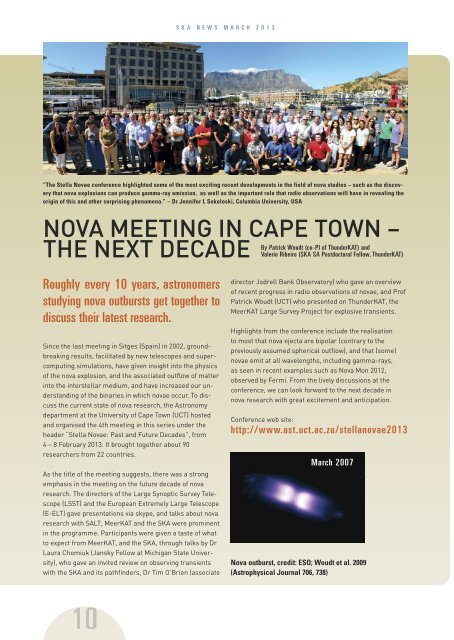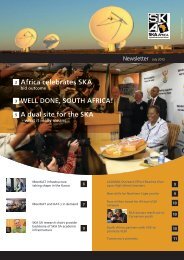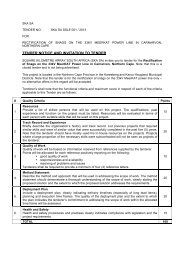S K A N E W S M A R C H 2 0 1 3“The Stella Novae conference highlighted some of the most exciting recent developments in the field of nova studies – such as the discoverythat nova explosions can produce gamma-ray emission, as well as the important role that radio observations will have in revealing theorigin of this and other surprising phenomena.” – Dr Jennifer L Sokoloski, Columbia University, USANOVA MEETING IN CAPE TOWN –THE NEXT DECADEBy Patrick Woudt (co-PI of ThunderKAT) andValerio Ribeiro (<strong>SKA</strong> SA Postdoctoral Fellow, ThunderKAT)Roughly every 10 years, astronomersstudying nova outbursts get together todiscuss their latest research.Since the last meeting in Sitges (Spain) in 2002, groundbreakingresults, facilitated by new telescopes and supercomputingsimulations, have given insight into the physicsof the nova explosion, and the associated outflow of matterinto the interstellar medium, and have increased our understandingof the binaries in which novae occur. To discussthe current state of nova research, the Astronomydepartment at the University of Cape Town (UCT) hostedand organised the 4th meeting in this series under theheader “Stella Novae: Past and Future Decades”, from4 – 8 February <strong>2013</strong>. It brought together about 90researchers from 22 countries.As the title of the meeting suggests, there was a strongemphasis in the meeting on the future decade of novaresearch. The directors of the Large Synoptic Survey Telescope(LSST) and the European Extremely Large Telescope(E-ELT) gave presentations via skype, and talks about novaresearch with SALT, MeerKAT and the <strong>SKA</strong> were prominentin the programme. Participants were given a taste of whatto expect from MeerKAT, and the <strong>SKA</strong>, through talks by DrLaura Chomiuk (Jansky Fellow at Michigan State University),who gave an invited review on observing transientswith the <strong>SKA</strong> and its pathfinders, Dr Tim O’Brien (associatedirector Jodrell Bank Observatory) who gave an overviewof recent progress in radio observations of novae, and ProfPatrick Woudt (UCT) who presented on ThunderKAT, theMeerKAT Large Survey Project for explosive transients.Highlights from the conference include the realisationto most that nova ejecta are bipolar (contrary to thepreviously assumed spherical outflow), and that (some)novae emit at all wavelengths, including gamma-rays,as seen in recent examples such as Nova Mon 2012,observed by Fermi. From the lively discussions at theconference, we can look forward to the next decade innova research with great excitement and anticipation.Conference web site:http://www.ast.uct.ac.za/stellanovae<strong>2013</strong><strong>March</strong> 2007Nova outburst, credit: ESO; Woudt et al. 2009(Astrophysical Journal 706, 738)
S K A N E W S M A R C H 2 0 1 3FOCUS ON HIGH-PERFORMANCESIGNAL PROCESSINGA workshop on high-performance signal processing washeld at the University of Cape Town (UCT) from 28 – 31January <strong>2013</strong>. The workshop, funded by the South African<strong>SKA</strong> Project, provided engineers and scientists with an opportunityto share ideas on the technology underpinninghigh-performance computing, and to present signal processingto young students considering a career in a fieldcritical to the MeerKAT and <strong>SKA</strong>, and to almost everyother high-tech engineering industry.(by Morgan Morris, see3 Communications)I N T E R N A -The <strong>SKA</strong> will not only require super computing power, butalso a daunting level of signal processing, explains FrancoisKapp, the digital back-end subsystems manager onthe MeerKAT project. The processing work will includereceiving, cleaning up or filtering, storing and sorting thesignal received by the atennas, as well as converting thesesignals from analogue to a more useable digital format.A sizeable portion of the technology will be outsourced toindustry, notes Kapp. Luckily, he says, industry andMeerKAT / <strong>SKA</strong> are working off the same script. “Everyone’sscaling up, building supercomputers for a multitudeof applications, of which we (radio astronomy), are just oneapplication.” However, much of the technology has alreadybeen developed in-house by Kapp and his team: notablythe ROACH hardware platform – which the students got touse at the UCT workshop.ROACH, or the Reconfigurable Open Architecture ComputingHardware, is an integrated circuit board developedwithin the Collaboration for Astronomy Signal Processingand Electronics Research (CASPER). The collaboration includesengineers, students and academics from the Universityof California, Berkeley; Caltech; the US NationalRadio Astronomy Observatory; the MeerKAT project team;and the University of Cape Town. ROACH’s standout sellingpoint, other than its significant processing power, is that itcan be configured, or rewired even after it has left the labbench – thus its moniker – to execute different computingtasks. In contrast, traditional computer chips are designedto perform only one or two specific tasks, be it generatinggraphics or running a car’s electronics.Tapping into the latest advances in FPGA integrated-circuittechnology, short for field-programmable gate array,ROACH boards can perform a variety of tasks really well,and super-fast. So much so that ROACH-2, with five timesthe processing capacity of its predecessor, can now befound doing duty in a multitude of instruments in a multitudeof places. By one count, over 300 ROACH boards havebeen deployed at research facilities internationally.Speakers at the UCT signals processing workshop included, from left, JasonManley (DSP team, <strong>SKA</strong> SA), Prof David Davidson (<strong>SKA</strong> SA Research Chair,Stellenbosch University), Prof Justin Jonas (Associate Director for Science andEngineering, <strong>SKA</strong> SA), Prof Mike Inggs (Engineering, UCT), Dr Andrew van derByl (Engineering, UCT), Francois Kapp (DSP, <strong>SKA</strong> SA), Prof Matthew Bailes(Swinburne University, Australia), and Sias Malan MeerKAT(DSP team, <strong>SKA</strong> SA).“The board is now the heart and soul of important radioastronomy instruments all over the world,”– Prof Mike Inggs, one of the hosts of the UCT workshop.The RHINO (reconfigurable hardwareinterface for computing and radio)platform is a pared-downversion of the ROACH boardsbeing developed by the SoftwareDefined Radio Group atUCT. It is a cheaper versionof ROACH, designed fortraining in reconfigurablecomputing, rather than forrunning specialised instruments,explains Inggs.The workshop, notes co-host, UCTresearch officer Dr Andrew van derByl, exposed the engineering and astronomyworlds to both signal processing and reconfigurablecomputing. It also helped to entice students into a fieldthat, thanks to MeerKAT and the <strong>SKA</strong> projects, will keepscience and industry busy for years. Especially as the workof radio astronomy and signals processing – its hardwareand algorithms – can be applied to the likes of telecommunications,radar, encryption, even banking.“The way things are going, there are always new avenuesto explore and new things to do.” – Dr Andrew van der Byl, UCT








